Envisioning the Campus of Tomorrow
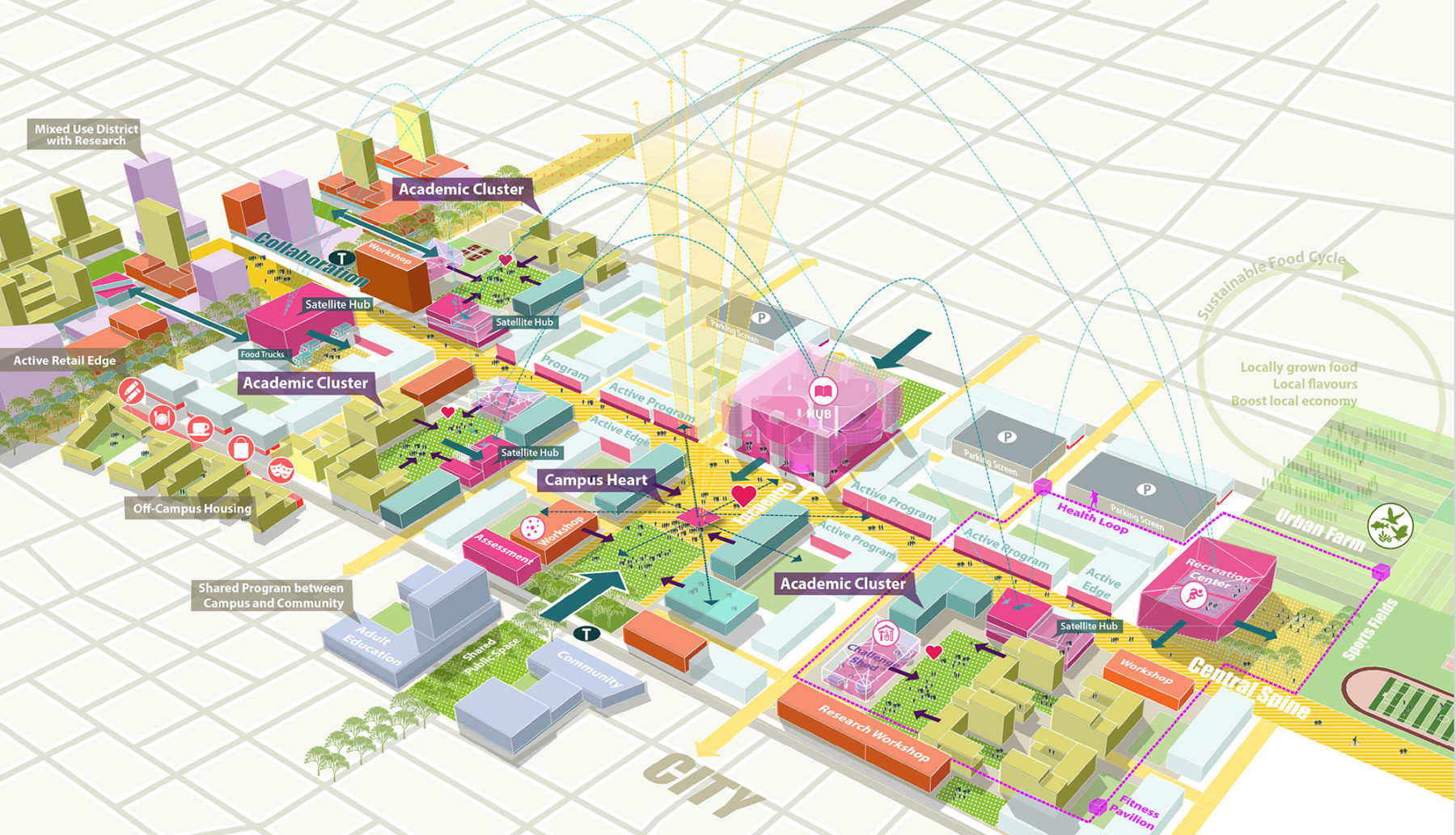
 Sasaki
Sasaki

“Perhaps the most exciting breakthrough is the realization that we do not live in an age of virtual or real, but in an era where the power of information technology allows us to create entirely new knowledge and beauty at the intersection of the virtual and the real.” – Mary Sue Coleman, President of the Association of American Universities
We are venturing into the 4th Industrial Revolution—in which automated systems, 5G networks and the Internet of Things (IoT), virtual reality, and other emergent technologies will change how we live, learn, and work. Faced with these changes, education systems around the world are transforming their offerings to better educate and prepare students for employment in a fast-shifting economic landscape. Digital learning environments expand students’ reach far beyond the classroom and the campus, enabling them to make interdisciplinary connections that better prepare them for the workforce and for life. Campus-level moves are in constant dialogue with broader cultural and economic changes, creating exciting opportunities to transform how teaching, learning, and research take place.
Intercultural and interpersonal skills will form the crux of the future workplace, and developing a pedagogical environment that encourages students to collaboratively address real-world challenges will be critical to being successful in this century. To address these shifts, universities are increasingly encouraging holistic and open-ended approaches to developing individuals, focused on the “four C’s”: critical thinking, communication, collaboration, and creativity. These elements are vital in forming students into lifelong learners who can adapt and engage in self-directed learning to continuously refresh their skills.
Likewise, the student life experience is also fast-evolving. Many universities we work with in India, Singapore, and other Asian countries are starting to build complete residential campuses—living-learning communities that promote strong social bonds, increase opportunities for peer-to-peer learning, and create a 24/7 campus experience.
Today’s educators and administrators face the rewarding challenge of balancing tried-and-true methods with a host of newer technology and approaches. How can colleges and universities find the right vision that works for their institution? And what are the defining elements of the 21st century campus? And, how does a university—centuries-old or built-from-scratch—infuse their campus spaces and population with these elements? Through flexibility, a commitment to holistic health, a reexamination of technology integrations, and the development of a hands-on problem-solving pedagogy, institutions can increasingly help their students develop the intellectual framework and skills that today’s global economy demands. The following illustrates our approach to creating a flexible, adaptable, and enduring 21st campus.
Many colleges and universities are redefining learning environments to facilitate diverse and varied instruction, with heavy emphasis on multi-disciplinary and collaborative learning, entrepreneurial thinking, and experiential project-based exercises rooted in real-world conditions. The classroom scale is the ideal testing ground for adaptable campus principles. Flexibility can enable different programming needs on a day-to-day basis (reorganization of classroom furniture and technology to support class activity), for special events during the semester (demonstrations, crits, and exams), or as part of campus-wide activities (student life forums, student organizations meetings).
Digital fabrication can support classroom flexibility through the creation of a new generation of prefabricated and modular building types. The design of these types takes place in a fully-integrated computational environment, where every aspect of the facility, its components, and its performance, are modelled, and its constituent parts are pre-designed as a set of families and elements. This approach creates an intrinsically flexible system in which buildings, despite higher upfront costs compared to traditional construction systems, retain the ability to adapt and evolve to new programs and needs—ensuring long-term utility and relevance.
This approach can be extended to the overall campus level to develop a flexible framework that establishes a strong sense of place, connectivity networks, and broader landscape systems. Adaptable program clusters then slot into these larger campus systems. Each cluster is comprised of an array of interrelated components—building typologies, open spaces, shaded walkways and planting systems. The configuration of specific clusters is based on a combination of pedagogical criteria, desired programmatic adjacencies and inside/outside spatial relationships. A toolkit of clusters include all required components—academic, housing, research—and are designed in conjunction with open space typologies. These clusters can be combined in myriad ways, and can establish new relationships between traditional departments.
With flexible clusters as the primary organizing elements, campuses can easily flex and morph to respond to evolving growth needs and programmatic requirements. The future campus is also rooted in a deep understanding and integration of environmental systems, such as hydrology, habitat, and topography, to create a layered framework that enhances the broader ecosystem and creates a rich and diverse natural setting for the campus.
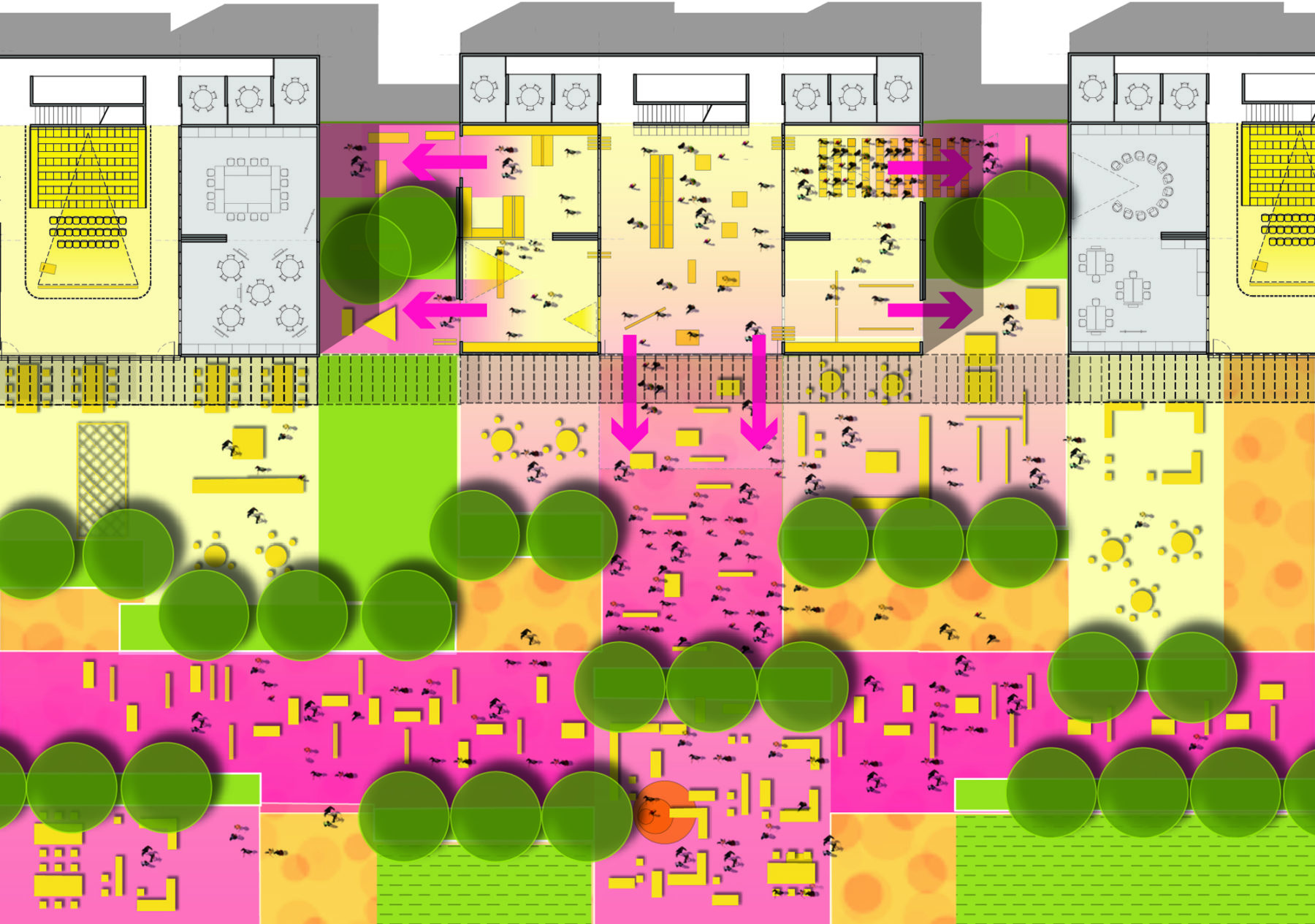
Development of a typology of flexible and adaptable building clusters that operate as shared resources accommodating a diversity of program needs and establish strong inside/outside relationships. [Project Reference: Campus Puebla, Mexico]
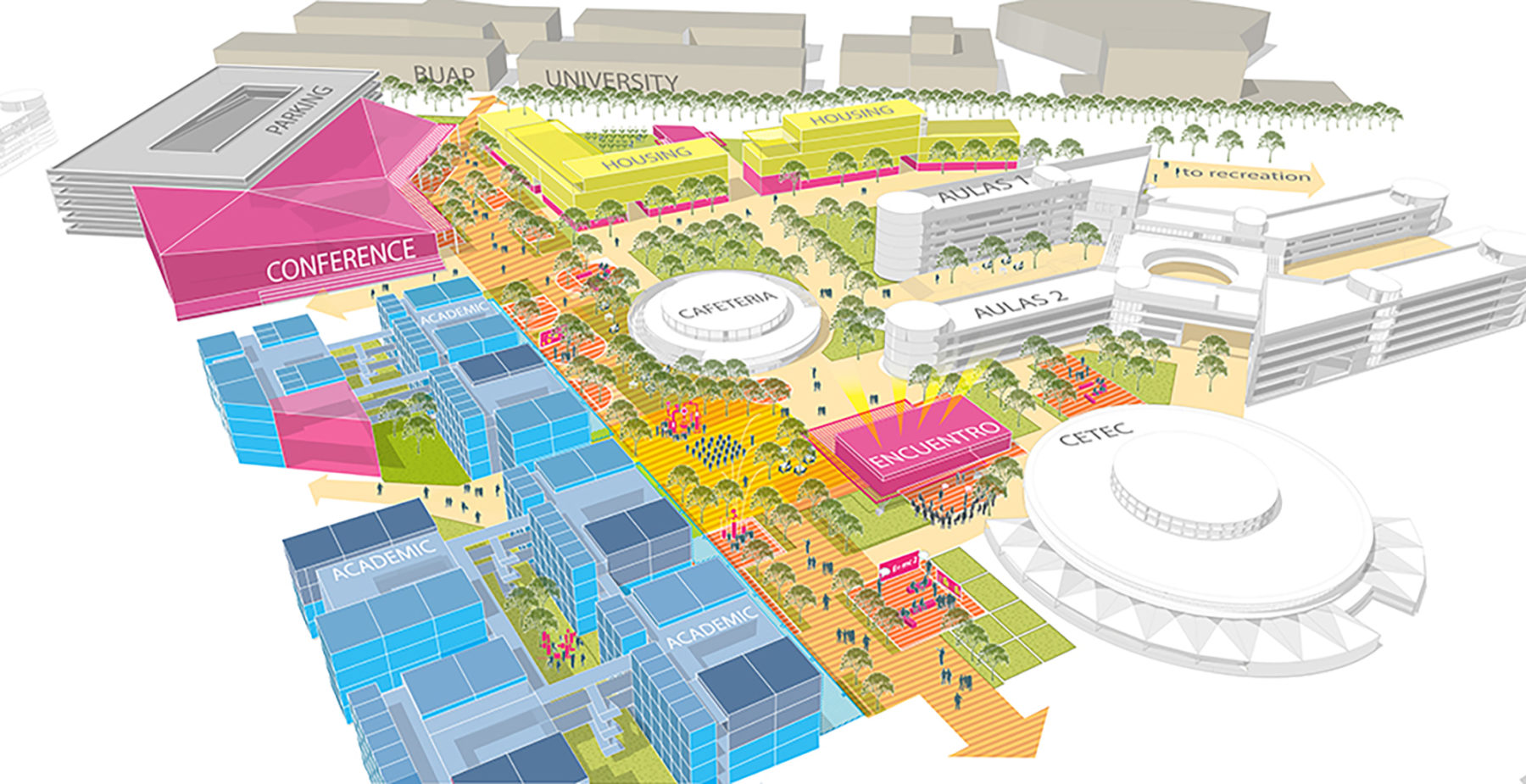
Application of flexible building clusters into a campus setting. [Project reference: Campus Puebla, Mexico]
A truly sustainable campus is inherently better connected to its environment, efficient in the use and replenishment of natural resources, comfortable to its occupants, and easy to maintain. Additionally, longevity is a key component of sustainable design, and is also a critical aspect of future adaptability. Buildings designed for change and adaption enable refits instead of demolish-and-rebuilds. Over time, this approach significantly reduces costs, waste, and carbon footprint. Sustainable and flexible building design, combined with the thorough integration of optimized infrastructure systems and resilient landscape design, will help achieve greater levels of environmental stewardship, and are the keys to creating a zero net energy/carbon neutral campus.
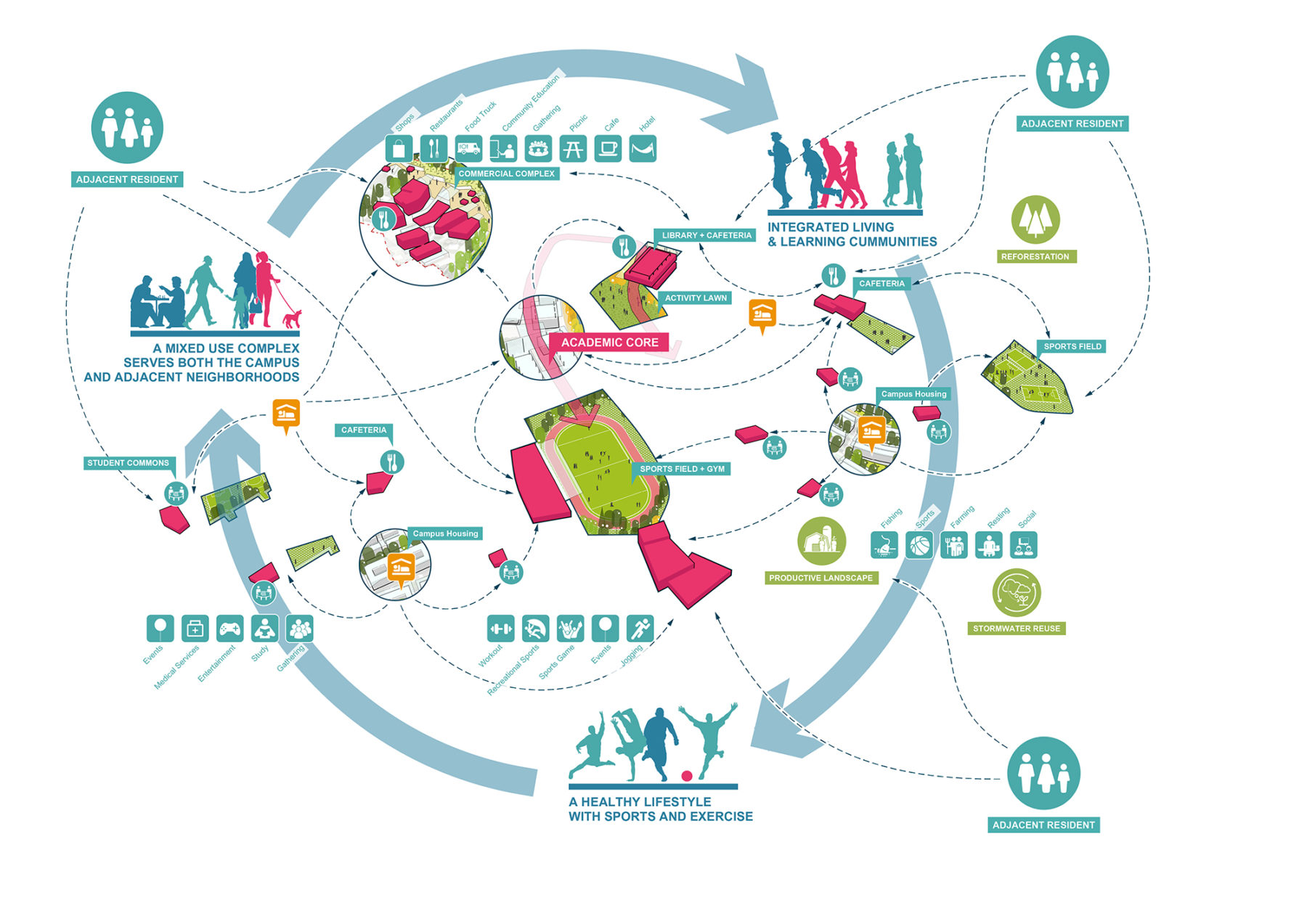
The campus of the future is envisoned as a holistic living/learning environment with a varied array of social, wellness, and recreational amenities integrated through out the campus. [Project reference: West Java New University, Indonesia]
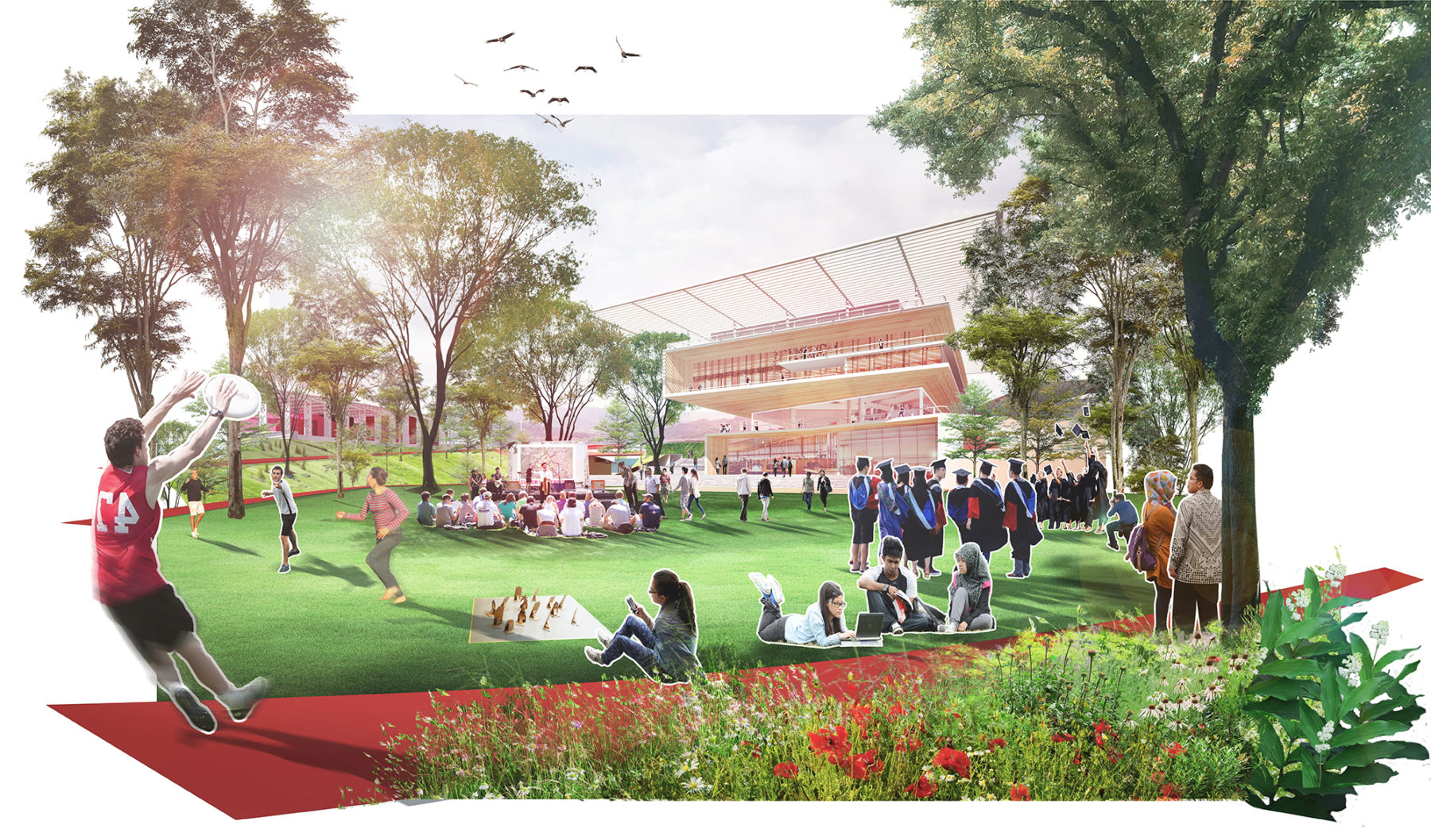
The landscape is designed to facilitate both formal and informal activities, and to create spaces that are universally designed and accessible to a diverse student population. [Project reference: West Java New University, Indonesia]
The burgeoning holistic wellness movement promotes environmental and programmatic elements that support many aspects of daily life: physical, emotional, intellectual, spiritual, social, and financial well-being. This envisioned future campus emphasizes the holistic development of each student—mind, body, and spirit—by integrating diverse forms of active and passive recreation, social spaces, green spaces, and inclusive environments. A diverse array of facilities form the spine of student and faculty life on campus. Academic and social life are seamlessly integrated, and a series of indoor and outdoor gathering spaces and courtyards support informal learning and socializing. Complemented by a robust wellness program, this campus provides crucial access not only to fitness and recreation facilities, but also equally important health and nutrition-related information and counseling.
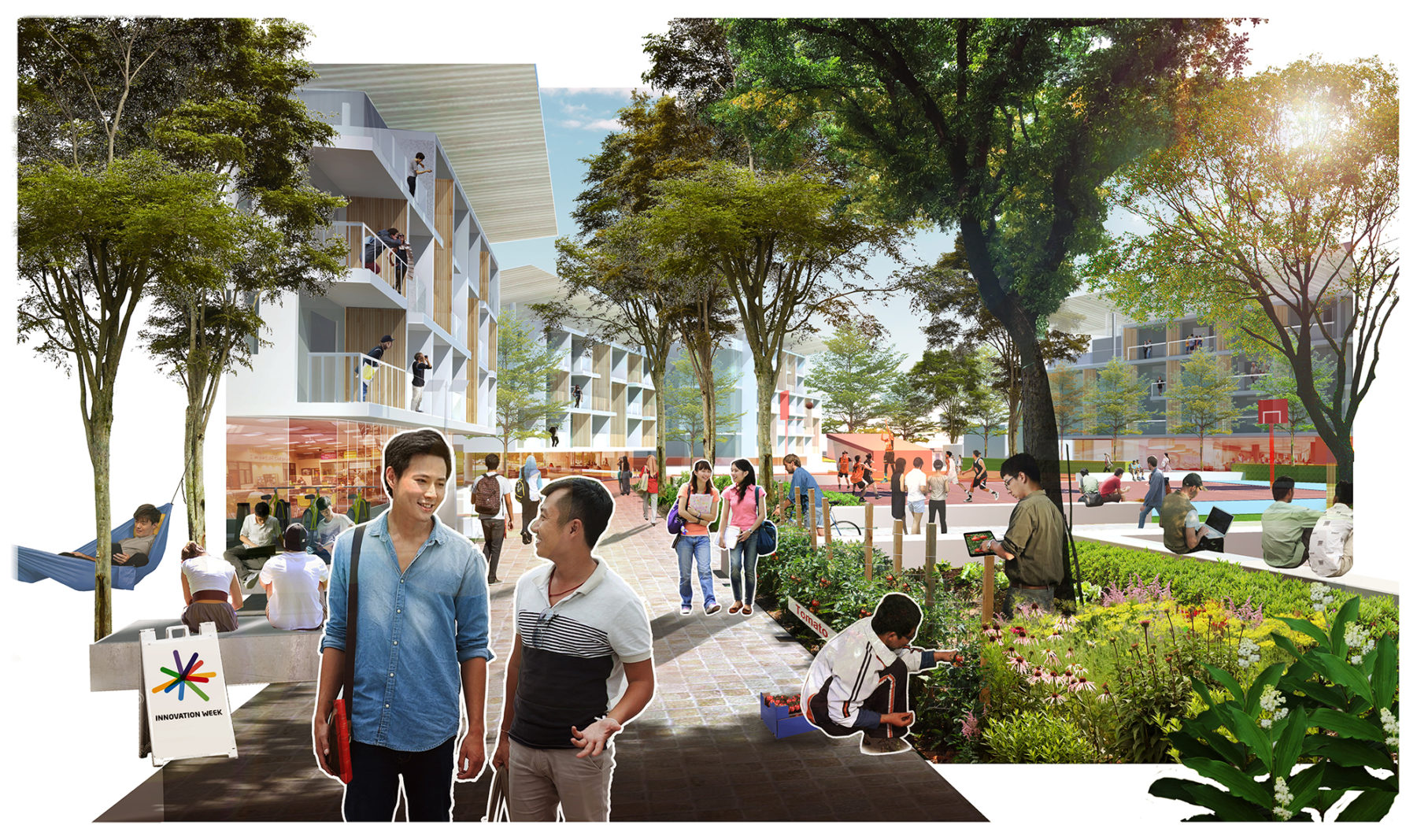
Housing clusters are designed to foster communal and social bonds and extend the learning environment, creating integrated living/learning communities. [Project reference: West Java New University, Indonesia]
The modern campus is anchored in cutting-edge yet adaptable technologies that facilitate 21st century education. The development of a resilient digital infrastructure system leverages cloud-based platforms and data visualization to create a virtual platform for teaching, learning, knowledge dissemination, operations, maintenance, and resource management.
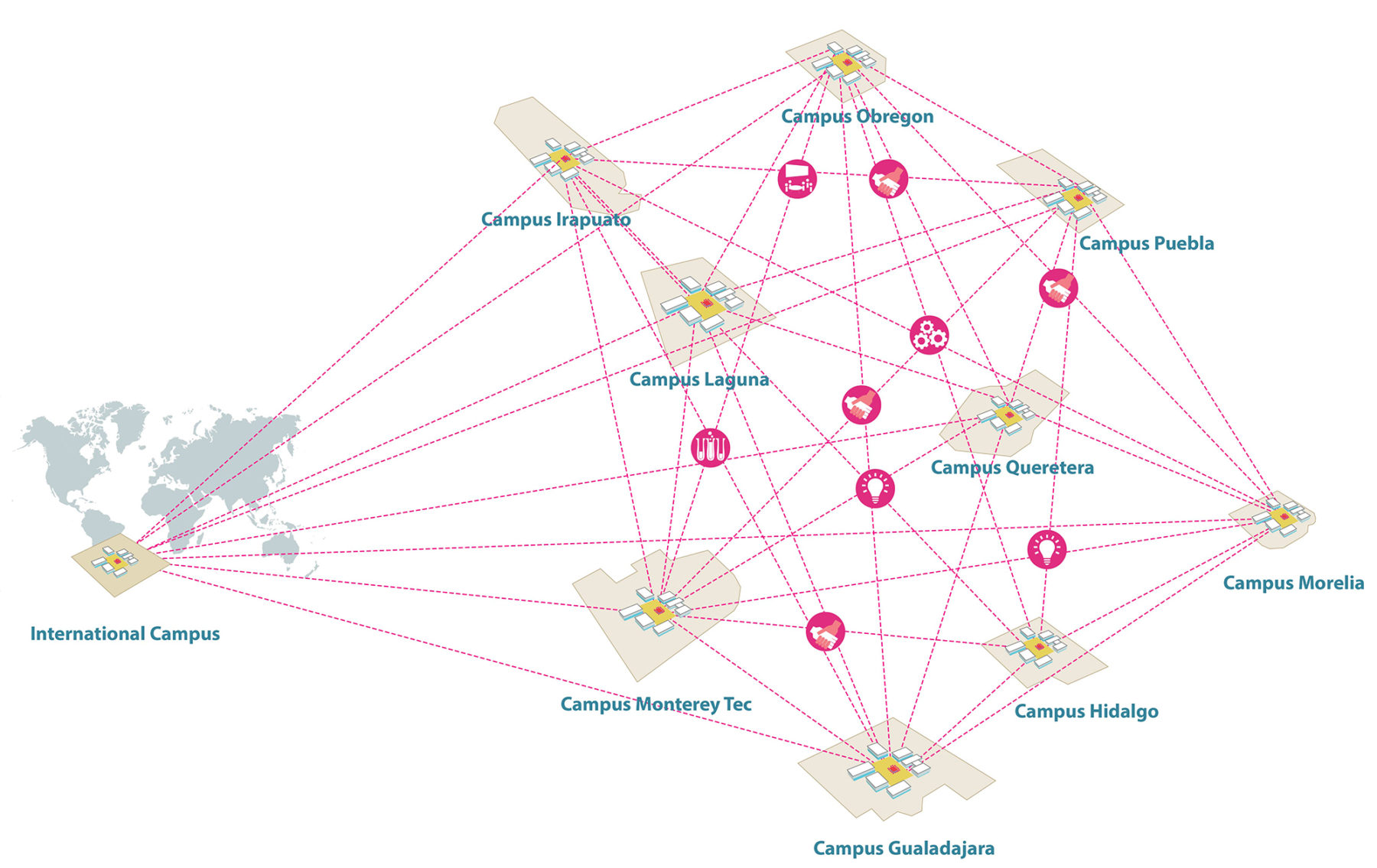
An integrated digital network will enable universities to tap into a global network of peer institutions and foster new forms of dialogue and collaboration. [Project reference: Tec 21 Vision Plan, Mexico]
Technology will be utilized to create fully-immersive simulated environments, non-immersive computer simulated environments and hybrid physical / digital spaces that create safe, less resource-intensive environments for experimentation. As part of a holistic and scalable digital network integration of 5G networks, the enhanced use of augmented and virtual reality (AR / VR) and wearables in teaching, learning, and research will become ubiquitous. Next-gen maker spaces will capitalize on the powerful digital-to-physical production environment.
Virtual reality, telepresence, and digital representation technologies will form global portals that allow universities to be at the forefront of disseminating knowledge, engaging in a global discourse and showcasing work. Digital infrastructures will connect universities to institutions and businesses, locally and globally. Universities will increasingly focus on experiential, project-based learning facilities, personalized learning paradigms, MOOCs (massive open online classes), and online certification programs.
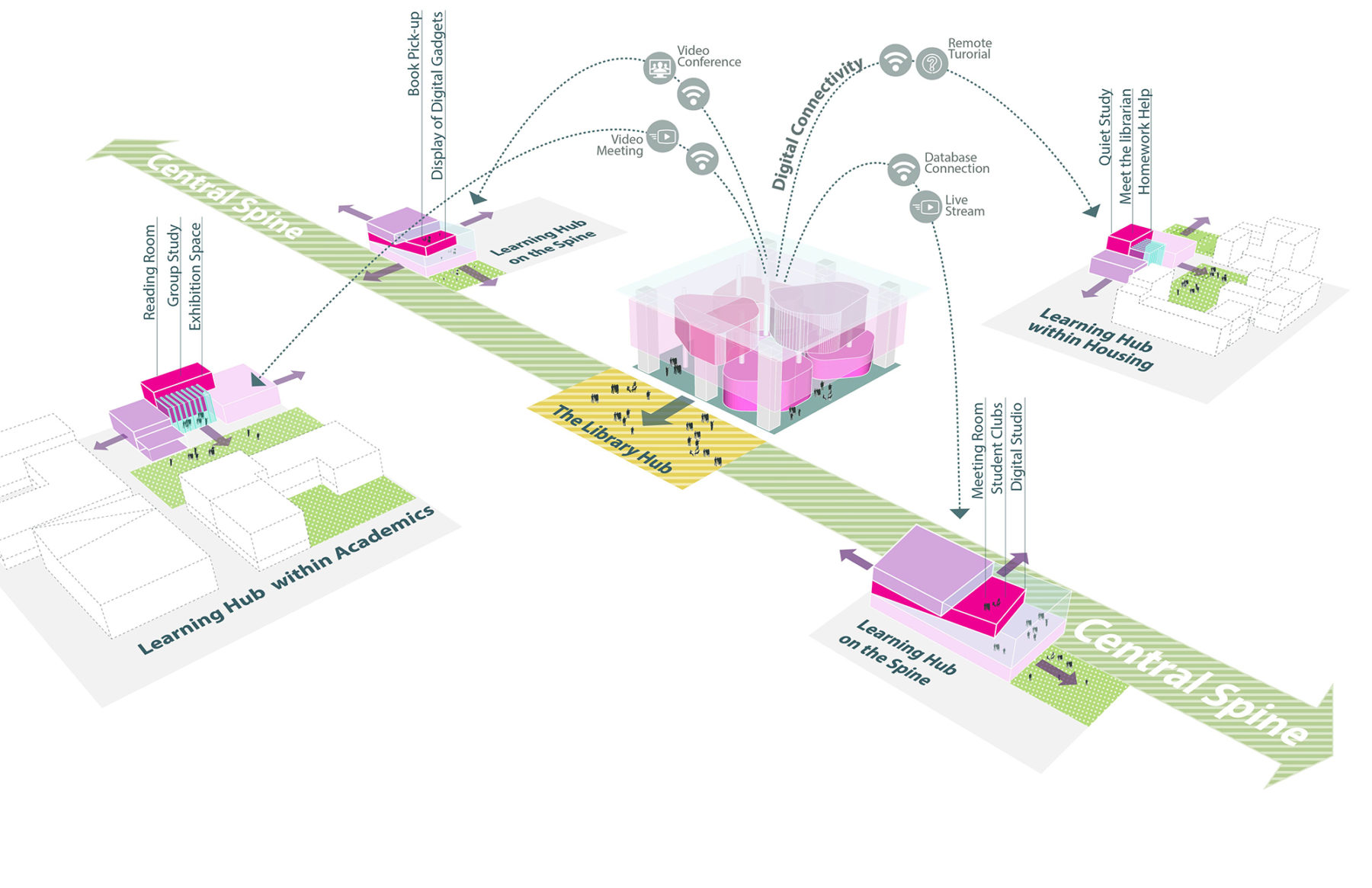
Technology also enables the development of a varied and decentralised program distribution to make shared facilities more accessible, reduce operational costs, and enhance collaboration. [Project reference: Tec 21 Vision Plan, Mexico]
“Learning by creating” is a revolutionary force in which ideas of prototyping, disrupting, hacking, and making are taking traditional education and workplaces by storm. This movement is creating great opportunities for universities to rethink models, break down silos, and engender new forms of multidisciplinary thinking.
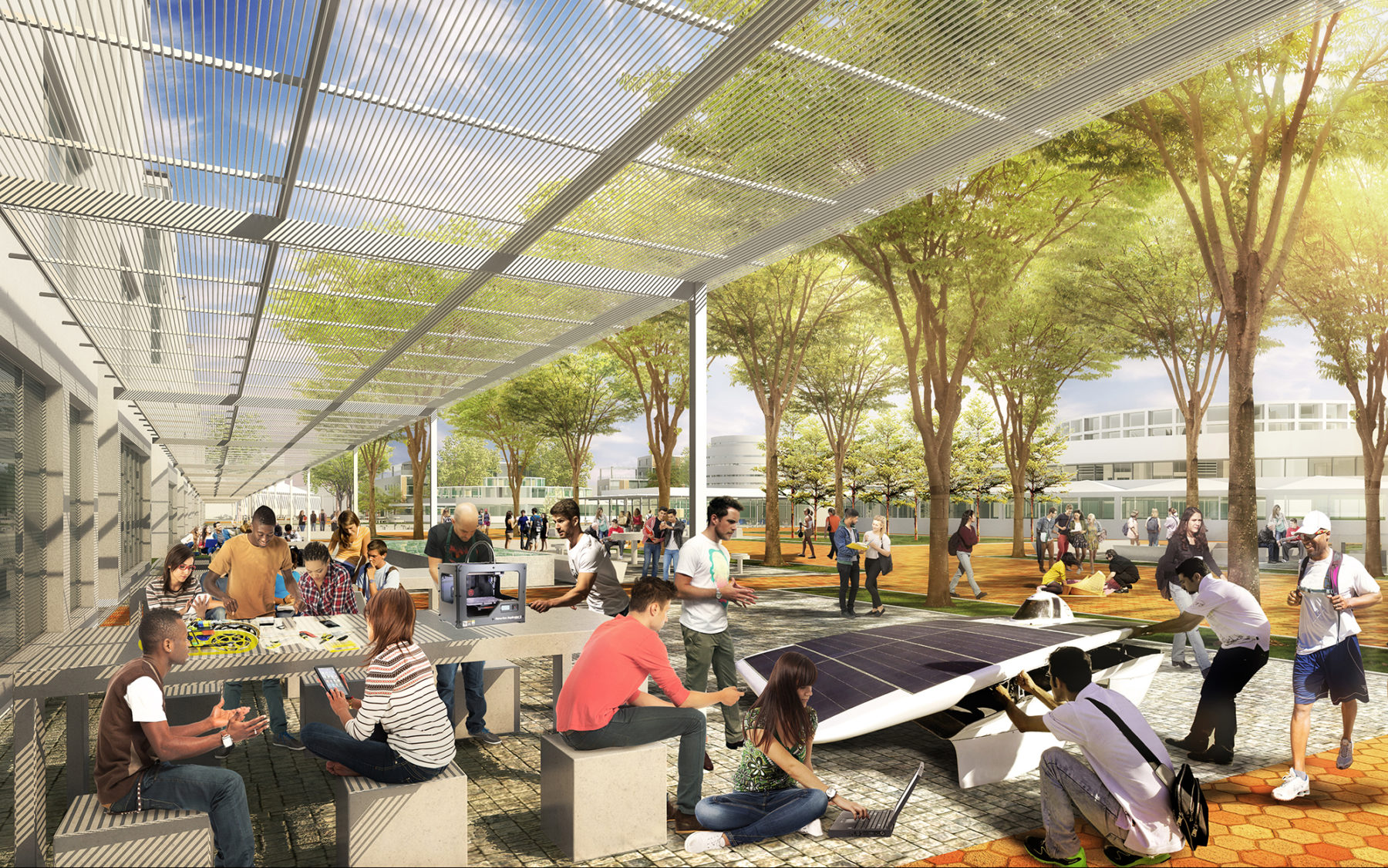
The campus becomes a living lab for facilitating experiential project-based learning and developing full-scale solutions to real world challenges. [Project Reference: Campus Puebla, Mexico]
One doesn’t have to look back many years to see just how much change our world—culturally, economically, and environmentally—has undergone. And, as the digital age matures, it is apparent that we’re ever on the cusp of more change—evidenced by increased connectivity, automation and a host of other game-changing technologies now being lumped under the umbrella of the 4th Industrial Revolution. Today’s students need to be prepared for a global economy marked by change, and a focus on interdisciplinary and collaborative learning offers the resiliency that the next-generation workforce needs to better sync with changing economies and in-demand skillsets.
In the push-and-pull of old and new, how can colleges and universities find the vision that works for their institution? We structure our approach around the four elements explored above: a flexible campus environment, design that emphasizes the holistic health of people and the planet, embracing new technology as a digital infrastructure, and a pedagogical focus on experimentation and problem-solving.